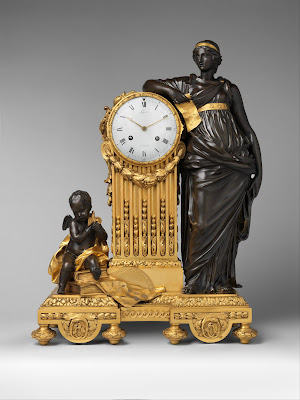I've recently "finished" a clumsily rendered and frivolous little painting ... my dumbed-down version of nine muses ... mine are riding on nine unicorns ... no classical or mythical authenticity there then ... and accompanied by nine magpies, the Pierides ...
The painting lay neglected for over a year until i remembered the story of the Pierides and added the nine magpies ... now i like to think that all are heading to Las Vegas for a lucrative re-match at Caesar's Palace ... can we assume that writer's block and artist's block are the same ?
During the gradual course of becoming interested in the Muses, i compiled a scrapbook in the form of a Word Document ( MY NINE MUSES ) that filled about a hundred pages, mostly with images ... i'm going to transfer some of them into my blog, along with some links and descriptions that seemed helpful to me at the time ... condensing this may take some time ...
the first stage of the project was trying to identify the nine names and then to see if there was a standard list of attributes, a consistent iconography ... fat chance ! after thousands of years, how could there be ?
But first ... a provisional list of their names and their special talents ...
and then
CALLIOPE, MUSE OF EPIC
POETRY, she’s holding a book
Goddess of Eloquence, Mother of Orpheus
https://www.theoi.com/Ouranios/MousaKalliope.html
Calliope by Simon Vouet, 1634
… wearing red and yellow
https://www.nga.gov/collection/art-object-page.46160.html
Calliope with books, Italy,
late 17th Century
https://www.christies.com/lot/lot-5097661/?intObjectID=5097661
Calliope Mourning Homer
https://harvardartmuseums.org/collections/object/230368?position=230368
CLIO … MUSE OF HISTORY
she holds a book, too ...
https://en.wikipedia.org/wiki/Clio
https://www.theoi.com/Ouranios/MousaKleio.html
Clio by Simon Vouet,
Karlsruhe Kunsthalle

Clio by Charles Meynier
https://www.clevelandart.org/art/2003.6.5#
Clio by Francois Boucher, 1742
https://histoirebnf.hypotheses.org/3809
Corot ...
https://www.metmuseum.org/art/collection/search/435978?ft=Parnassus&offset=80&rpp=40&pos=86
Vermeer ...The Art of Painting ...
some people suggest that Vermeer's young model is posing as CLIO ...
... but there are other interpretations ...
https://en.wikipedia.org/wiki/The_Art_of_Painting
EUTERPE … Muse of Flutes and
Music
https://www.theoi.com/Ouranios/MousaEuterpe.html
Euterpe by Simon Vouet
https://www.sothebys.com/en/auctions/ecatalogue/2014/the-courts-of-europe-n09107/lot.113.html

Euterpe, by Goltzius
http://hdl.handle.net/10934/RM0001.COLLECT.438362
Euterpe, Albertina Museum ... can’t find it described on their website
Sculptor Joseph Klieber, part of a set of Apollo and the Nine Muses
Carved in Sandstone with a mock-marble finish
THALIA
https://www.theoi.com/Ouranios/MousaThaleia.html
Thalia, probably Italian,
Anglesey Abbey
https://artuk.org/discover/artworks/thalia-the-muse-of-comedy-and-pastoral-poetry-170258
Emma Hamilton as Thalia
https://www.metmuseum.org/art/collection/search/817160
Thalia, Meissen, c.1745
https://www.christies.com/en/lot/lot-5440169
hoppner, dorothea jordan as the comic muse
MELPOMENE
https://www.theoi.com/Ouranios/MousaMelpomene.html
Melpomene, Wall plaque found
in Petra
https://universes.art/en/art-destinations/jordan/amman/museums/jordan-museum/nabataean-hall/melpomene
Melpomene Muse of Tragedy,
Elisabeta Sirani, before 1625
Melpomene, Thorvaldsen, 1836
TERPSICHORE
https://www.theoi.com/Ouranios/MousaTerpsikhore.html
TERPSICHORE,
Muse of Lyric Poetry and Dancing
https://www.clevelandart.org/art/1968.212
Francesco Bartolozzi
https://www.metmuseum.org/art/collection/search/381819?ft=Terpsichore&offset=0&rpp=40&pos=2
Terpsichore, Anglesey Abbey

ERATO
https://www.theoi.com/Ouranios/MousaErato.html
Erato, Clock by Claude Galle,
France, late 18th Century
https://www.proantic.com/en/display.php?id=641106
Erato, Charles Meynier, about
1800
https://www.clevelandart.org/art/2003.6.2
Erato, Lord Leighton
https://www.sothebys.com/en/buy/auction/2021/master-paintings-sculpture-part-i/erato
The Muse of Poetry, Sir Edward Poynter
POLYHYMNIA
https://www.theoi.com/Ouranios/MousaPolyhymnia.html
Polyhymnia by Simon Vouet,
around 1645
https://collections.louvre.fr/en/ark:/53355/cl010059598
Polyhymnia
https://www.rct.uk/collection/search#/1/collection/41046/polyhymnia-daughter-of-zeus
Polyhymnia, Meissen, late 19th
Century,
https://www.freemansauction.com/auction/lot/603-impressive-group-of-meissen-porcelain-figures-of-muses/?lot=428110&sd=1
URANIA
https://www.theoi.com/Ouranios/MousaOurania.html
Urania, amongst others
Bernard Picart, 1730
https://www.britishmuseum.org/collection/object/P_1956-0725-83
Urania,
https://www.metmuseum.org/art/collection/search/196531?searchField=All&sortBy=Relevance&ft=Urania&offset=0&rpp=20&pos=13
Urania, a volume of poems,
1950, with a cover by the exquisite woodcarver Joan Hassall
Urania, Raphael mosaic, Vatican
THE MUSES IN CROWD SCENES
https://www.britishmuseum.org/collection/image/823355001
https://collections.louvre.fr/en/ark:/53355/cl010066788
HISTORY: Presumably the painting seen by [André] Félibien in Rome in 1647. Possibly, anonymous sale, Banqueting House, Whitehall, London, 1684. Spanish Royal Collection by 1746.
"The Parnassus is a free variant of Raphael's fresco in the Vatican [directly below], with a not very skillful attempt to fill the gap – due in Raphael's composition to the window – by the insertion of the nymph of the Castalian spring, an awkward figure reminiscent of the School of Fontainebleau in its proportions. In certain respects Poussin has followed Marcantonio's engraving [also below] more closely than the painting. The putti, for instance, which occur in the engraving and in Poussin's painting, are not to be seen in the fresco. Erwin Panofsky believes that [Poussin's] painting is a tribute to [Poussin's early patron, the then-famous poet Giovanni Battista] Marino, and nothing would be more likely than that Poussin should have painted such a subject soon after the poet's death in 1625."
Engraved by ??? Morgen after Anton Mengs
painted by Heinrich Maria von Hess, 1826
Engraved by Christophe Guerin after Giulio Romano
copied by baldassare peruzzi from giulio romano
tintoretto, 1578
a sevres lash-up in the royal collection
Kerel van Mander, late 1500s
albert decaris, mid 1900s
mark severin, late 1900s
westmacott, 1852 ... the pediment/tympanum at the main entrance to the british museum some muses, but not all ...

https://historicengland.org.uk/research/results/reports/6696/ACOLLECTIONOFREPORTSANDPAPERSONTHEBRITISHMUSEUM
... to be continued ...
















.png)





.jpg)
.jpg)




















-Apollo-and-the-Muses-on-Parnassus-c1626-29-oil-on-canvas-Museo-del-Prado-Madrid%20(1).jpg)

.jpg)






.jpg)


